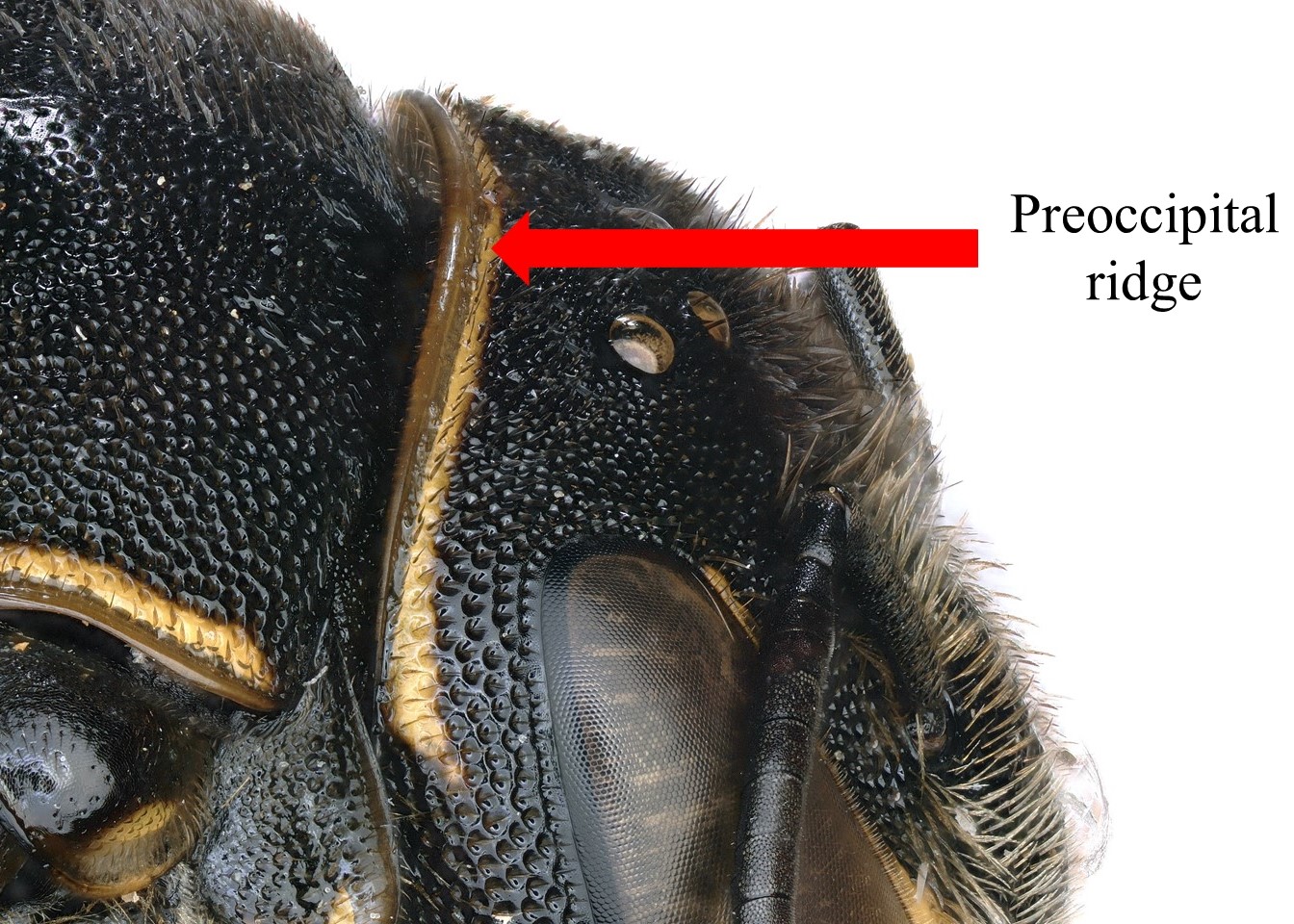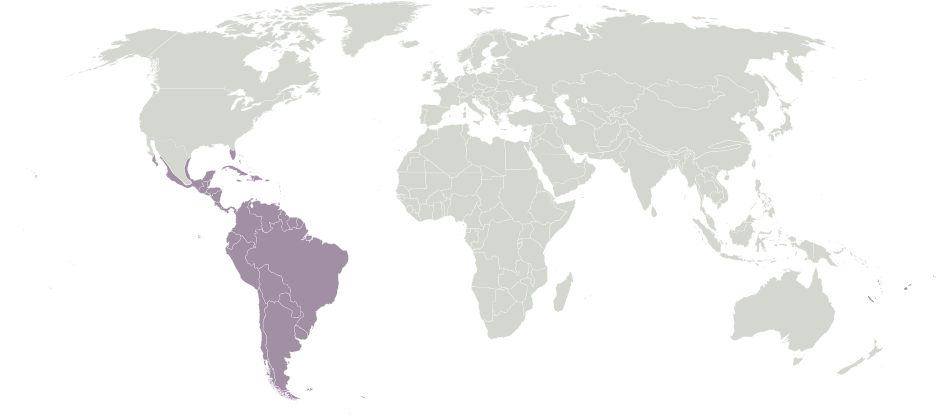Family: Megachilidae
Subfamily: Megachilinae
Tribe: Anthidiini
Genus: Anthodioctes Holmburg, 1903
Subgenera: Anthodioctes, Bothranthidium
Common name: none
Anthodioctes are small, slender, coarsely punctatepunctate:
studded with tiny holes
bees that range in body length from 4.5–10.5 mm. They typically have black integumentintegument:
a tough, protective outer layer
with limited yellow or no maculations on the face, thorax, and T1T1:
the segments on the top side of the abdomen, often abbreviated when referring to a specific segment to T1, T2, T3, T4, T5, T6, or T7 to T2T2:
to T2T2:
the segments on the top side of the abdomen, often abbreviated when referring to a specific segment to T1, T2, T3, T4, T5, T6, or T7 , and complete yellow-colored bandsbands:
, and complete yellow-colored bandsbands:
usually referring to bands of hair or bands of color that traverse across an abdominal segment
on apicalapical:
near or at the apex or end of any structure
terga (Michener 2007Michener 2007:
Michener, C.D. 2007. The Bees of the World (2nd ed.). Johns Hopkins University Press, Baltimore and London, 953 pp.).
Anthodioctes contains 58 species worldwide (ITIS 2017ITIS 2017:
ITIS. Retrieved [Jul, 12, 2017], from the Integrated Taxonomic Information System on-line database, http://www.itis.gov .); none are known to occur in the U.S. or Canada.
(modified from Michener 2007Michener 2007:
Michener, C.D. 2007. The Bees of the World (2nd ed.). Johns Hopkins University Press, Baltimore and London, 953 pp.)
 pronounced carinacarina:
pronounced carinacarina: lacking laterallateral:
lacking laterallateral: is small and bilobed.
is small and bilobed.Anthodioctes may be confused with Hypanthidioides due to similar external characters; however, Anthodioctes differs from Hypanthidioides in the presence of the preoccipital carinacarina:
a clearly defined ridge or keel, not necessarily high or acute; usually appears on bees as simply a raised line
and foveafovea:
a depressed region of cuticle; in bees this depressed area is usually only very slightly hollow and usually on the face.
between the scutumscutum:
the large segment on top of the thorax located between the wings and behind the head
and scutellumscutellum:
shield shaped plate behind scutum (Michener 2007Michener 2007:
Michener, C.D. 2007. The Bees of the World (2nd ed.). Johns Hopkins University Press, Baltimore and London, 953 pp.).
There are no known invasives.
Anthodioctes are solitary bees which nest in preexisting cavities. Nest linings, partitions, and closures may be comprised of collected resin as shown for A. lunatus (Camarotti-de-Lima and Martins 2005Camarotti-de-Lima and Martins 2005:
Camarotti-de-Lima, M. and C.F. Martins. 2005. Biologia de nidificaccedil;atilde;o e aspectos ecoloacute;gicos de Anthodioctes lunatus (Smith) (Hymenoptera: Megachilidae, Anthidiini) em aacute;rea de tabuleiro nordestino, PB. Neotropical Entomology 34: 375ndash;380.). Resin can be mixed with wood particles as in A. moratoi (Morato 2001Morato 2001:
Morato, E.F. 2001. Biologia e ecologia de Anthodioctes moratoi Urban (Hymenoptera, Megachilidae, Anthidiini) em matas contiacute;nuas e fragmentos na Amazocirc;nia Central, Brazil. Revista Brasileira de Zoologia 18: 729ndash;736.), or other debris such as sand, wood, or paper as in A. megachiloides (Alves-dos-Santos 2004Alves-dos-Santos 2004:
Alves-dos-Santos, I. 2004. Biologia de nidificaccedil;atilde;o de icaccedil;atilde;o de Anthodioctes megachiloides Holmberg (Anthidiini, Megachilidae, Apoidea). Revista Brasileira de Zoologia 21: 739ndash;744.). Nests may consist of multiple cells arranged in a linear series with partitions also made of resin (Morato 2001Morato 2001:
Morato, E.F. 2001. Biologia e ecologia de Anthodioctes moratoi Urban (Hymenoptera, Megachilidae, Anthidiini) em matas contiacute;nuas e fragmentos na Amazocirc;nia Central, Brazil. Revista Brasileira de Zoologia 18: 729ndash;736.). Anthodioctes manauara uses the abandoned nests of potter and mason wasps (Eumeninae), which sculpt mud into various pot-like and tubular-shaped nests (Morato 2001Morato 2001:
Morato, E.F. 2001. Biologia e ecologia de Anthodioctes moratoi Urban (Hymenoptera, Megachilidae, Anthidiini) em matas contiacute;nuas e fragmentos na Amazocirc;nia Central, Brazil. Revista Brasileira de Zoologia 18: 729ndash;736.; Alves-dos-Santos 2010Alves-dos-Santos 2010:
Alves-dos-Santos, I. 2010. Anthodioctes megachiloides nesting in an abandoned nest of Brachymenes dyscherus (Hymenoptera: Megachilidae; Vespidae). Journal of the Kansas Entomological Society 83: 39ndash;91.). Anthodioctes megachiloides has also been found nesting inside abandoned Vespidae wasp clay nests (Alves-dos-Santos 2010Alves-dos-Santos 2010:
Alves-dos-Santos, I. 2010. Anthodioctes megachiloides nesting in an abandoned nest of Brachymenes dyscherus (Hymenoptera: Megachilidae; Vespidae). Journal of the Kansas Entomological Society 83: 39ndash;91.). Fungi, the cleptoparasitecleptoparasite:
bees that lay their eggs in the nest cells of bees in other genera. Their larvae depend on the pollen provided by their host. Since cleptoparasitic bees don't provision their own nests, and instead depend on the pollen collected by their host, the females lack pollen collecting hairs. This often gives them a wasp-like appearance.
Sapyga, and the parasitoid Mellitobia (Eulophidae) have been found in Anthodioctes nests (Alves-dos-Santos 2003Alves-dos-Santos 2003:
Alves-dos-Santos, I. 2003. Trap-nesting bees and wasps on the University Campus in Satilde;o Paulo, Southeastern Brazil (Hymenoptera, Aculeata). Journal of the Kansas Entomological Society 76: 328ndash;334., 2004; Camarotti-de-Lima and Martins 2005Camarotti-de-Lima and Martins 2005:
Camarotti-de-Lima, M. and C.F. Martins. 2005. Biologia de nidificaccedil;atilde;o e aspectos ecoloacute;gicos de Anthodioctes lunatus (Smith) (Hymenoptera: Megachilidae, Anthidiini) em aacute;rea de tabuleiro nordestino, PB. Neotropical Entomology 34: 375ndash;380.).
Anthodioctes are restricted to the Western Hemisphere and are NeotropicalNeotropical:
biogeographic region that includes South and Central America, the Caribbean Islands, southern Florida, and the southern Mexican lowlands in distribution, ranging from Chihuahua in northern Mexico south to Buenos Aires, Argentina (Michener 2007Michener 2007:
in distribution, ranging from Chihuahua in northern Mexico south to Buenos Aires, Argentina (Michener 2007Michener 2007:
Michener, C.D. 2007. The Bees of the World (2nd ed.). Johns Hopkins University Press, Baltimore and London, 953 pp.).
Distribution map generated by Discover Life -- click on map for details, credits, and terms of use.
Alves-dos-Santos, I. 2003. Trap-nesting bees and wasps on the University Campus in São Paulo, Southeastern Brazil (Hymenoptera, Aculeata). Journal of the Kansas Entomological Society 76: 328–334.
Alves-dos-Santos, I. 2004. Biologia de nidificação de icação de Anthodioctes megachiloides Holmberg (Anthidiini, Megachilidae, Apoidea). Revista Brasileira de Zoologia 21: 739-744.
Alves-dos-Santos, I. 2010. Anthodioctes megachiloides nesting in an abandoned nest of Brachymenes dyscherus (Hymenoptera: Megachilidae; Vespidae). Journal of the Kansas Entomological Society 83: 39-91.
Camarotti-de-Lima, M. and C.F. Martins. 2005. Biologia de nidificação e aspectos ecológicos de Anthodioctes lunatus (Smith) (Hymenoptera: Megachilidae, Anthidiini) em área de tabuleiro nordestino, PB. NeotropicalNeotropical:
biogeographic region that includes South and Central America, the Caribbean Islands, southern Florida, and the southern Mexican lowlands Entomology 34: 375-380.
Entomology 34: 375-380.
ITIS. Retrieved [Jul, 12, 2017], from the Integrated Taxonomic Information System on-line database, http://www.itis.gov.
Michener, C.D. 2007. The Bees of the World (2nd ed.). Johns Hopkins University Press, Baltimore and London, 953 pp.
Morato, E.F. 2001. Biologia e ecologia de Anthodioctes moratoi Urban (Hymenoptera, Megachilidae, Anthidiini) em matas contínuas e fragmentos na Amazônia Central, Brazil. Revista Brasileira de Zoologia 18: 729-736.